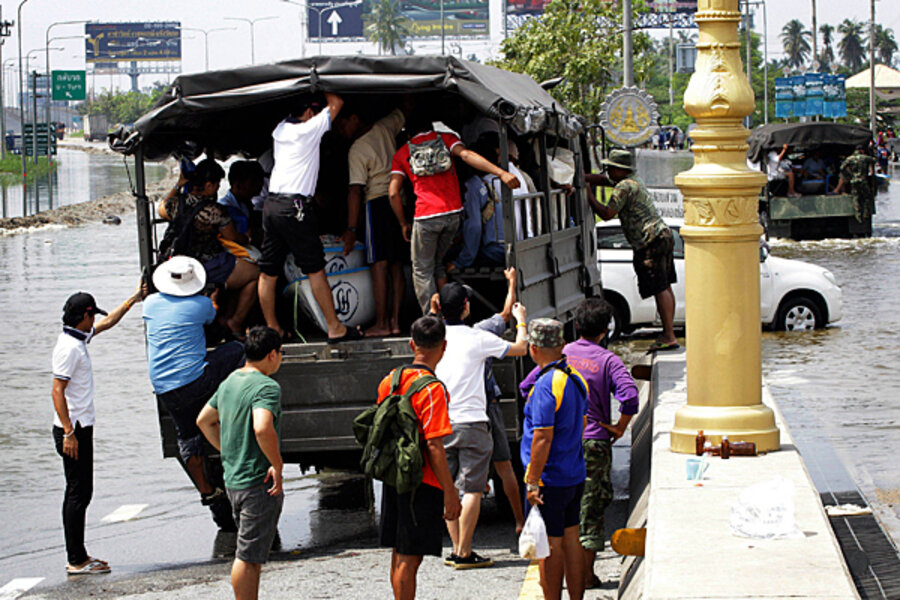Thailand's worst floods in decades reach Bangkok as political fallout mounts
Loading...
| Bangkok
As rescue workers provide aid to rest of Thailand inundated with the worst floods in half a century, high waters have arrived in Bangkok’s northern suburbs.
Large parts of Southeast Asia including Laos, Cambodia, Vietnam, and the Philippines have been flooded for the past month. Of the nearly 700 flood-related deaths throughout the region, some 342 have occurred in Thailand, according to the government. More than half of the 77 provinces have been affected, primarily in the north.
Some 40,000 Thai Army troops have been deployed to build flood walls, set up sandbags, and help evacuations. Thai Airways and other logistics companies have been instructed to pitch in.
But, citizens are beginning to express frustration with the way the new government has handled the disaster, opening up the possibility that the floods could become a divisive political issue as different agencies begin to point fingers. The government has been vague with its predictions and information, say residents.
An editorial cartoon published in local English-language newspaper The Nation suggested that the floods meant the end of Thailand's honeymoon with Prime Minister Shinawatra, who has been criticized for wearing expensive Burberry boots to visit flood victims.
Newly appointed international Flood Relief Operations Command (FROC) spokesperson Sean Boonpracong says there’s a “50-50” percent chance water levels will continue to rise. “The real concern is how long it will take for the water to subside.”
A recent study carried out by Assumption University shows the FROC scores just 3.36 out of 10 for performance. The government seems to disseminate inconsistent or contradictory information, frequently issuing warnings only to retract them, suggesting relief efforts are discombobulated and disorganized.
For weeks, panic buying has emptied shelves of Bangkok grocery stores of essentials such as drinking water, candles, and instant noodles.
Beginning early Friday morning, the Prapa canal, which feeds into Bangkok's Metropolitan Waterworks Authority plant, began overflowing after sluice gates were opened in a controversial move to relieve flooding in the north. In the most-affected neighborhoods, water stands more than one meter deep, where Army rescue teams on trucks have gone to help trapped residents. Further north in Pathum Thani district, water stands over two meters (6 feet) deep.
Newly elected Prime Minister Yingluck Shinawatra delcared 17 districts in Bangkok disaster areas, in order to facilitate relief efforts. “Please understand that the water comes from opening water gates to drain the water as soon as possible,” she said in the announcement, “we have to let the water flow smoothly. We know that water is now trapped in the plains and many areas. With the drainage, trapped water will drop fast.”
Thursday evening, Bangkadi Industrial Park became the seventh industrial estate to fall victim to the floods, which destroyed the factories of electronics and electrical appliances manufacturers like Sony and Toshiba. The ancient capital of Ayutthaya has seen its 400-year-old temples and UNESCO heritage sites go under water, and car manufacturing plants have been inundated as well. The government has estimated the floods will shave 0.9 percent off GDP growth this year.
According to Smith Dharmasarojana, a meteorological expert who predicted the Indian Ocean tsunami, it could take up to three months for the flood to pass. “We’ve had unprecedented amounts of rain, due to the typhoons in the South China Sea, rising sea levels slowing down the flow of the river, and the need to drain water from the floods in the north through Bangkok and out to the sea. These three factors have contributed to the flood danger. Last time we were flooded like this it took three months for the water to drain.”





